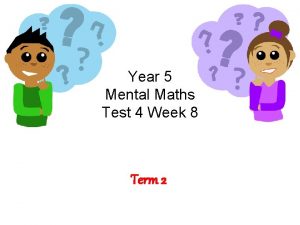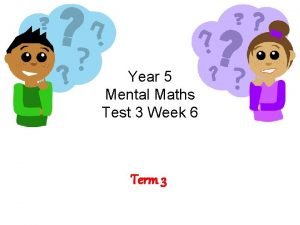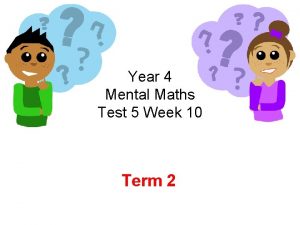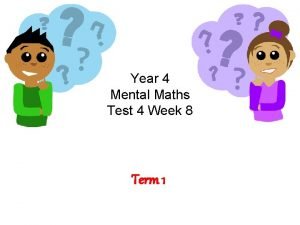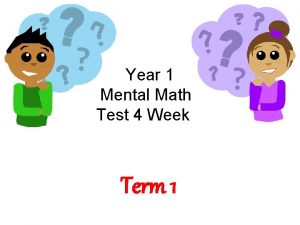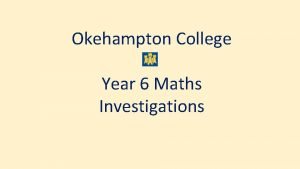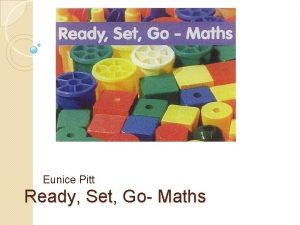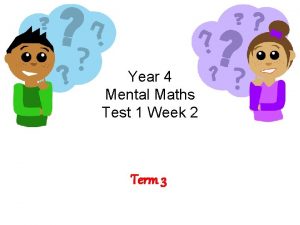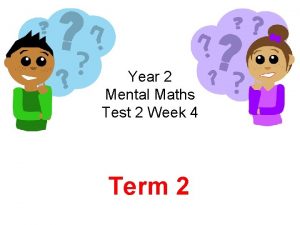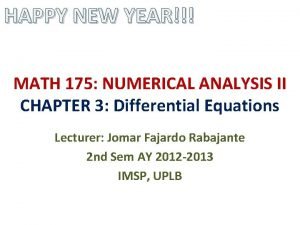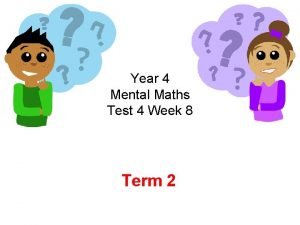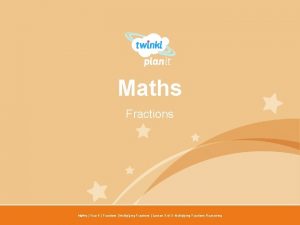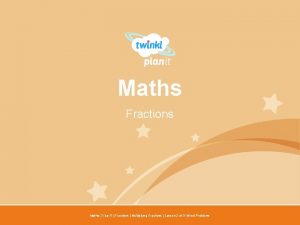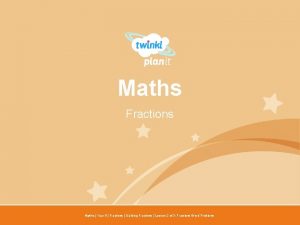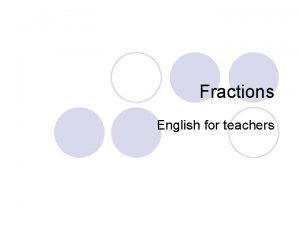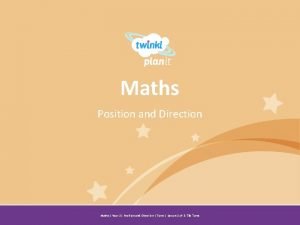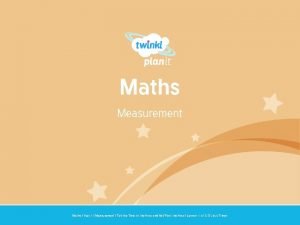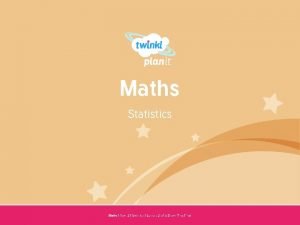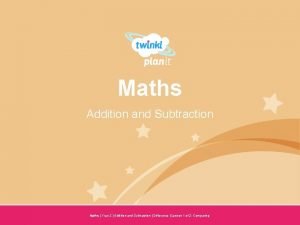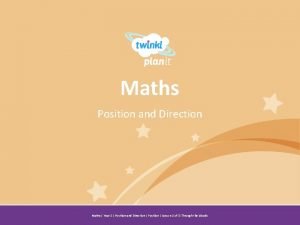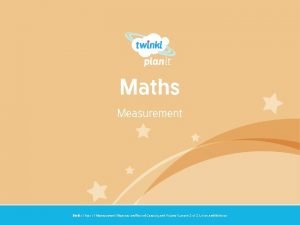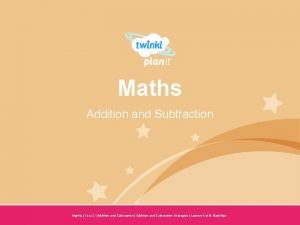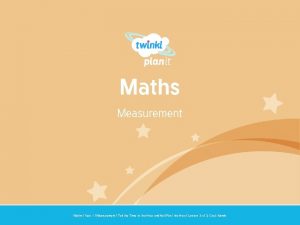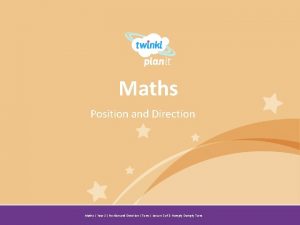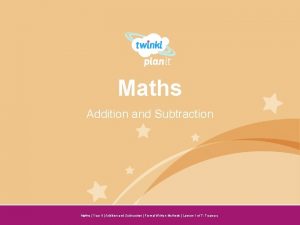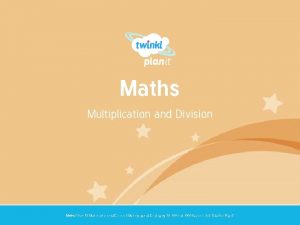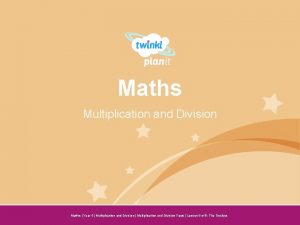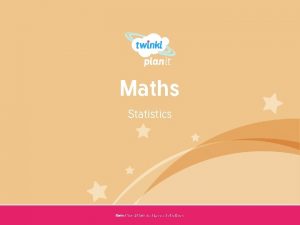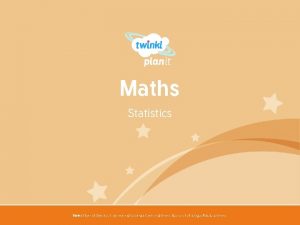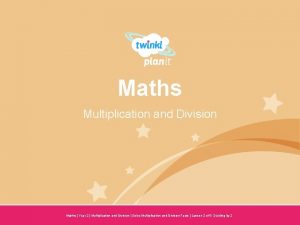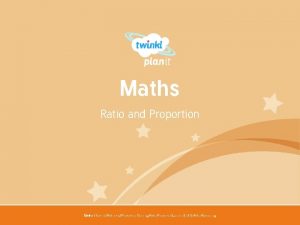Maths Fractions Year One Maths Year 6 Fractions

























- Slides: 25

Maths Fractions Year One Maths | Year 6 | Fractions | Multiplying Decimals | Lesson 3 of 3: Decimal Multiplication Reasoning


Aim • I can solve reasoning questions involving multiplying one-digit numbers with up to two decimal places by whole numbers. Success Criteria • I can break down complex problems into smaller steps. • I can use mathematical language to explain solutions to problems.

Guided Maths Question 1 Read this reasoning question carefully. Calculate the missing numbers in this multiplication grid: × 20 100 18 30 Let’s highlight the important information and key vocabulary to show we understand the question.

Guided Maths Question 1 Next, let’s think about what we already know in order to help us answer the question correctly. Calculate the missing numbers in this multiplication grid: × I know that multiplication Identifying thethat firsta couple I know and division are inverse of multiplication missing numbers will grid operations, and I can use then helpnumbers me to find the multiplies through this to help me find the other partitioning. missing numbers. 20 100 18 30 × 20 × ? = 100 ÷ 20 = ? 20 100 30 18 20 × ? = 18 18 ÷ 20 = ?

Guided Maths Question 1 Next, let’s think about what we already know in order to help us answer the question correctly. Calculate the missing numbers in this multiplication grid: × 20 First, I can calculate: Finally, cancalculate: Next, I Ican Now, 20 × ? = 100 6? ××× 0. 9 ? 20 18 5? ===30 100 ÷ 20 = ? 100 18 30 I can calculate that 20 × 9 = 180. 20 × Therefore, 5 = 100 I can reason that 20 × 0. 9 = 18. ? × 5 = 30 6 × 5 = 30 × 5 0. 9 20 100 18 6 30 5. 4 6 × 0. 9 = ? 6 × 0. 9 = 5. 4

Guided Maths Question 1 Finally, let’s check our answer. Calculate the missing numbers in this multiplication grid: × 5 0. 9 20 100 18 6 30 5. 4

Partner Maths Question 1 Working with a partner, use your reasoning skills to answer this question. Calculate the missing numbers in this multiplication grid: × 5 0. 8 30 150 24 7 35 5. 6 Show Answer

Guided Maths Question 2 Read this reasoning question carefully. In this number pyramid, the number in every box is the product of the two numbers below it. Calculate the missing numbers. 6 3 0. 6 13 10 Let’s highlight the important information and key vocabulary to show we understand the question.

Guided Maths Question 2 Next, let’s think about what we already know in order to help us answer the question correctly. In this number pyramid, the number in every box is the product of the two numbers below it. Calculate the missing numbers. I know in thisa ISo know that in maths I know that division is the pyramid product each is thenumber result ofis inverse relationship to calculated multiplyingbytwo numbers multiplication. the two numbers together. below it. This number will be the answer to 3 × 0. 6. 3 6 0. 6 13 10 This number will be the answer to 13 ÷ 10 = ?

Guided Maths Question 2 In this number pyramid, the number in every box is the product of the two numbers below it. Calculate the missing numbers. Now we are ready to apply our learning to solve the question. Finally, I can Now, Next, I can calculate First, calculate 1. 8×÷× 0. 6. 10. 6. 313 6 × 13. 6 3 0. 6 13 10 To calculate 1. 8 × 6, I could To calculate 6 × 13, I can use partitioning or short calculate (6 × 10) + (6 × 3). multiplication. I know that 3 × 6 = 18. I know that 6 is ten times bigger than 0. 6, so the answer 18 is ten times bigger than the answer to 3 × 0. 6. I can reason that the answer to 3 × 0. 6 = 1. 8. 10. 8 6 1. 8 3 78 0. 6 13 10 1. 3 I know that when we divide by 10, the digits move one space to the right. So I know that the answer to 13 ÷ 10 = 1. 3.

Guided Maths Question 2 Finally, let’s check our answer with the information and key vocabulary in the question. In this number pyramid, the number in every box is the product of the two numbers below it. Calculate the missing numbers. 10. 8 6 1. 8 3 78 0. 6 13 10 1. 3

Partner Maths Question 2 Working with a partner, use your reasoning skills to answer this question. In this number pyramid, the number in every box is the product of the two numbers below it. Calculate the missing numbers. 25. 6 15 8 3. 2 4 120 0. 8 10 Show Answer 1. 5

Guided Maths Question 3 Read this reasoning question carefully. Use the multiplication fact 14 × 1. 6 = 22. 4 to calculate the answer to 25. 6 ÷ 1. 6 = 44. 8 ÷ 1. 6 = Let’s highlight the important information and key vocabulary to show we understand the question.

Guided Maths Question 3 Next, let’s think about what we already know in order to help us answer the question correctly. I know that I can use the I know that division is the given calculation to help inverse operation to me find the missing multiplication. answers. Use the multiplication fact 14 × 1. 6 = 22. 4 to calculate the answer to 25. 6 ÷ 1. 6 = 44. 8 ÷ 1. 6 = 25. 6 ÷ 1. 6 is the same as ? × 1. 6 = 25. 6 44. 8 ÷ 1. 6 is the same as ? × 1. 6 = 44. 8 14 × 1. 6 = 22. 4

Guided Maths Question 3 Now we are ready to apply our learning to solve the question. Use the multiplication fact If IIfind the difference Next, First, notice that the answer between answers, to ? ? ×× 1. 6 these 44. 8 two double the to == 25. 6 isisbigger than answer to 14 to × 1. 6, so 1. 6, Ihow know the answer 14 ×by so I I can discover that the missing number isis know multiples the missingof number many 1. 6, 25. 6 double 14. greater than is greater than 22. 4. to calculate the answer to 14 × 1. 6 = 22. 4 25. 6 ÷ 1. 6 = 44. 8 ÷ 1. 6 = 14 × 1. 6 = 22. 4 ? × 1. 6 = 25. 6 The difference is 3. 2. I know that 1. 6 × 2 = 3. 2, so I can find the difference between 22. 4 and 25. 6 by Therefore, 25. 6 is istwo greater 16 × than 1. 6 =of 22. 4. 25. 6. this calculation multiples 1. 6 greater than counting on from the smaller number. the given fact. ? × 1. 6 = 44. 8 22. 4 is 14 multiples of 1. 6; therefore, if I double this × 1. 644. 8 = 22. 4 so 28 1. 6 =many 44. 8. multiples number of 14 multiples, Iiswill find× 22. 4. how double equal 44. 8.

Guided Maths Question 3 Finally, let’s check our answer with the information and key vocabulary in the question. Use the multiplication fact 14 × 1. 6 = 22. 4 to calculate the answer to 25. 6 ÷ 1. 6 = 16 44. 8 ÷ 1. 6 = 28 Show Answer

Partner Maths Question 3 Working with a partner, use your reasoning skills to answer this question. Use the multiplication fact 12 × 2. 3 = 27. 6 to calculate the answer to 34. 5 ÷ 2. 3 = 15 55. 2 ÷ 2. 3 = 24 Show Answer

Reasoning Practice Have a go at independently solving the reasoning questions on your activity sheet.

Reasoning Practice Answers Did you correctly answer the first reasoning question? 1. Calculate the missing numbers in this multiplication grid: 1. × 5 0. 6 × 40 200 24 20 100 8 40 4. 8 4 200 Show Answer 1. Calculate the missing numbers in this multiplication grid: 50 5 20 Calculate the missing numbers in this multiplication grid: 0. 3 × 6 30 1. 2 Show Answer 40 4 0. 7 1200 120 21 9 360 36 6. 3 0. 2 8 0. 14 Show Answer

Reasoning Practice Answers Did you correctly answer the second reasoning question? 1. In this number pyramid, the number in every box is the product of the two numbers below it. Calculate the missing numbers. 24. 5 3. 5 5 In this number pyramid, the number in every box is the product of the two numbers below it. Calculate the missing numbers. 38. 4 84 4. 8 12 7 0. 7 1. 10 1. 2 Show Answer 6 In this number pyramid, the number in every box is the product of the two numbers below it. Calculate the missing numbers. 184 56. 7 243 364. 5 23 8 0. 8 1. 10 6. 3 2. 3 Show Answer 7 0. 9 27 9 10 13. 5 2. 7 Show Answer 5

Reasoning Practice Answers Did you correctly answer the third reasoning question? 1. Use the multiplication fact 16 × 2. 7 = 43. 2 to calculate the answer to 1. Use the multiplication fact 18 × 2. 8 = 50. 4 to calculate the answer to 1. Use the multiplication fact 18 × 3. 2 = 57. 6 to calculate the answer to 40. 5 ÷ 2. 7 = 15 56 ÷ 2. 8 = 20 44. 8 ÷ 3. 2 = 14 86. 4 ÷ 2. 7 = 32 100. 8 ÷ 2. 8 = 36 172. 8 ÷ 3. 2 = 54 Show Answers

Reasoning Practice How confident do you feel about the types of question that we have worked on today? Show me using a silent signal:

Aim • I can solve reasoning questions involving multiplying one-digit numbers with up to two decimal places by whole numbers. Success Criteria • I can break down complex problems into smaller steps. • I can use mathematical language to explain solutions to problems.

 In what year is act one, scene one set?
In what year is act one, scene one set? One god one empire one emperor
One god one empire one emperor One one little dog run
One one little dog run One king one law one faith
One king one law one faith Byzantine definition
Byzantine definition One ford behaviors
One ford behaviors See one do one teach one
See one do one teach one See one, do one, teach one
See one, do one, teach one Twelfth night speeches
Twelfth night speeches Studiendekanat uni bonn
Studiendekanat uni bonn Asean tourism strategic plan
Asean tourism strategic plan Graphic organizer with the aims of la liga filipina
Graphic organizer with the aims of la liga filipina Dr frost algebraic fractions
Dr frost algebraic fractions Mental maths year 5
Mental maths year 5 Mental maths year 5
Mental maths year 5 Year 4 mental maths tests
Year 4 mental maths tests Year 4 mental maths test
Year 4 mental maths test Year 3 mental maths test
Year 3 mental maths test Year 1 mental maths test
Year 1 mental maths test Maths mastery year 3
Maths mastery year 3 Year 6 maths investigations
Year 6 maths investigations Go maths
Go maths Year 4 mental maths tests
Year 4 mental maths tests Year 2 mental maths test
Year 2 mental maths test Non autonomous differential equation
Non autonomous differential equation Mental maths year 4
Mental maths year 4













